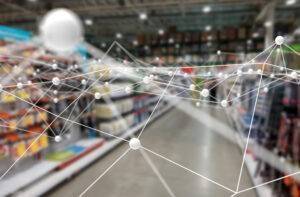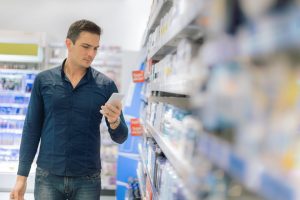How to leverage in-store digital marketing to boost sales
In-store digital marketing today looks very different than in-store digital marketing even five years ago. When looking to boost sales, brands and retailers should consider leveraging modern technology to build awareness around their products and convert browsers into loyal customers.
Studies show that customers who have a favorable in-store experience are more likely to return than those who have a very poor experience. With so many shoppers connected at work and at home, expectations are high for companies to adopt the latest digital technologies to also connect with consumers as they shop and improve the in-store experience.
1. Use Digital to Get Shoppers to the Store
Digital is a great channel for driving business offline. A study by Google revealed that 3 in 4 shoppers who find local information in search results are more likely to visit stores, ready to buy.
Why preface a shopping trip with an online surf session? Surveys reveal these digitally-engaged shoppers are routinely looking up the price of a particular item, whether items are locally in-stock, the hours of a store, maps to a product or retailer’s nearest location, and what other items are available in a store carrying the items initially searched.
When considering that nearly three-quarters of younger shoppers conduct research on a computer or mobile device before making an in-store purchase, it’s imperative that marketers leverage these channels to bring bodies to the store. Shoppers can take immediate action when they see the right inventory, at the right place, within the right proximity to their current location.
Advertising with Google Local is one way to reach local prospects, but it’s not the only way. Mobile shopping platforms like Shopkick are serving as valuable referrers of hyperlocal business. Shopkick retail and brand partners gain access to loyal app users who may be in the pre-trip planning phase or who may have just entered a store looking for a rewarding shopping experience.
2. Employ In-Store Digital Marketing to Convert and Retain
Once a captive audience enters a retail establishment, digital marketing tools can be used to move the shoppers down the sales funnel, reward desired actions, and inspire long-term loyalty. There are limitless ways to achieve these results, but some of the most effective methods include:
Point of Purchase (POP) Digital Displays
Digital displays have been around for a while, but their effectiveness at the point of purchase is undisputed. Early research indicated 68% of customers said digital signage would make them more likely to buy the product advertised. In fact, 44% said digital signage would influence them to buy the advertised product instead of a product they already planned to purchase. Neuroscience confirmed that moving digital signage imagery is 2.5 times as effective in creating an emotional response and recall compared to static images. In the real world, Nielsen tracked 120 grocers who debuted digital signage in their stores and found that 80% of them saw as much as a 33% boost in sales.
There are countless reasons to leverage POP digital signage:
- Digital signage is a great leveraging tool for retailers with space constraints. With digital signage, more information can be provided in a stimulating, high-tech, visual way to bring a brand’s story to life. Interactive displays can guide shoppers to find answers to common questions, freeing up floor staff to provide more personalized service. The use of interactive screens creates sustained interaction with a brand and boosts overall sentiment.
- Digital POP screens can adapt. Ads can change in real-time and be tailored depending on who is viewing them. Leading digital signage software platforms can integrate data streams from point-of-sale, inventory, weather feeds, sports scores, and other conditions. If stock runs out, the signs can intelligently change gears to advertise a more available product. If an athlete is trending, the sign can display that player’s jersey. If it’s a rainy day, products can be geared toward indoor activities or waterproof products.
- Digital displays can boost membership program effectiveness. Loyalty programs remain a popular measure of consumer satisfaction. Digital POP signage lets brands highlight the benefits of loyalty program membership, advertise members-only promotions, and tailor personalized ads triggered by the scanning of a loyalty card.
- Digital displays are a two-way street. Marketers not only project their messages outward with digital displays; they can also absorb data inward. How many people are viewing the display? What are they looking at? What are their demographics? What actions are they taking after looking at the display? Knowing these answers could produce more effective marketing.
Consider these examples for using POP digital signage in-store:
- Nordstrom’s “Digital Denim Doctor” uses intelligent programming and filters to offer personalized suggestions for jeans based on body type, lifestyle and fabric preferences.
- Sephora’s ModiFace digital display uses augmented reality that allows guests to try on store products without the use of makeup remover wipes, increasing sales nearly a third.
- Rebecca Minkoff’s “smart” mirrors allow shoppers to instantly summon additional garments or sizes to the fitting room, adjust the lighting, order a drink, or receive personalized suggestions for complementary products, increasing sales by over 200% as a result.
- An IGA supermarket in Canada rolled out a “Live Harvesting” campaign allowing customers to select rooftop produce to be hand-picked and delivered to them within the store in less than 10 minutes. Sales from the rooftop garden increased by 10 times.
Facial Recognition Technology
Facial recognition was one of the hot topics at the National Retail Federation annual expo in 2018, with retailers just starting to take advantage of the digital technology. Here are some of the ways retailers are using facial recognition:
- Linking rewards programs and payment information: CaliBurger links facial recognition to their opt-in loyalty program, so members can instantly access data from their loyalty accounts, such as favorite meals and past purchases. Going one step further, customers can also pay for their meals using this same technology. As a result, they cut the sale time from three minutes to one minute and 44 seconds, their loyalty program saw a 20% increase, and 69% of their loyalty members opted for facial recognition payment over manually swiping a credit card.
- For in-depth analytics: What are customers doing in the stores, how are they feeling, and what is driving their purchase behavior? Does facial recognition hold the key? Samsung and AT&T reported using facial recognition to track demographics and store traffic patterns. Similarly, Walmart has patented technology to capture shoppers’ facial expressions in checkout lines to measure levels of satisfaction and dissatisfaction, so they can improve store displays, promotions, and customer service.
- To improve customer service: In a candy store mock-up, Intel software showcased how their technology could effectively recognize individual shoppers, sending store associates to interact with the person using a first name, history of past purchases, and tailored recommendations that hit their “data-defined sweet spots.” Other brands like SAP Innovation Lab are experimenting with eyeglasses that feed employees customer metrics in real-time as they survey the salesfloor.
Facial recognition in retail is still in its early infancy, but one can imagine the implications of widespread adoption. For starters, it can make the shopping experience much more efficient with instant, self-service checkouts and eliminate bottlenecks when customers order online and come into a brick-and-mortar to pick up their purchases. It can be used to discourage shoplifters and prevent theft. What once might have been perceived as invasive technology holds much promise, as long as retailers are transparent about how they intend to use facial recognition and allow for opt-in. Shoppers have already proven they are willing to give up a little bit of anonymity in exchange for more satisfying shopping trips.
Mobile Reward Programs
Mobile devices are an easy technology to harness since 77% of shoppers use mobile devices to search for products and additional information in-store. They tap a wide range of resources: search engines (64%), mobile-enhanced websites (46%), retailer apps (46%), competitors’ sites (30%), and third-party apps (26%) in their quest for answers.
About half of all shoppers look for digital offers while shopping in-store, so it makes sense to link the in-store experience with a mobile rewards program. Loyalty programs are a great way to ask customers for data and permission to further communicate via mobile, SMS, push notifications, email, and social media. There should be little resistance to such opt-ins if the retailer or brand provides perceived value—like rewards points, notice of upcoming events, exclusive “VIP” perks, or personalized customer service.
Brands and retailers can take advantage of a partnership with an established mobile rewards shopping platform like Shopkick. In exchange for rewards points called “kicks,” loyal Shopkickers engage with partnering brands and retailers. For instance, a shopper can earn kicks by visiting a particular store, watching an in-app promotional video, locating an item in-store, or buying certain products and scanning their receipt.
Brands and retailers can take advantage of a partnership with an established mobile rewards shopping platform like Shopkick.
Kraft ran a campaign with Shopkick that delivered a 7:1 ROI, converting 55% of buyers from shoppers who hadn’t planned on buying the featured Kraft products before engaging with the Shopkick app in-store. Of the 9 million in-store product engagements, nearly a third of the traffic converted to sales.
Leveraging in-store digital marketing is likely to boost sales, as numerous examples illustrate. Industry leaders that are paying attention to these new developments and making thoughtful investments will ultimately be the ones to succeed.
Want a neat new way to leverage digital marketing in-store? Consider how our partners have implemented campaigns to boost sales. Contact Shopkick for details.



